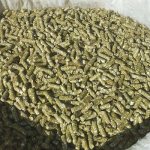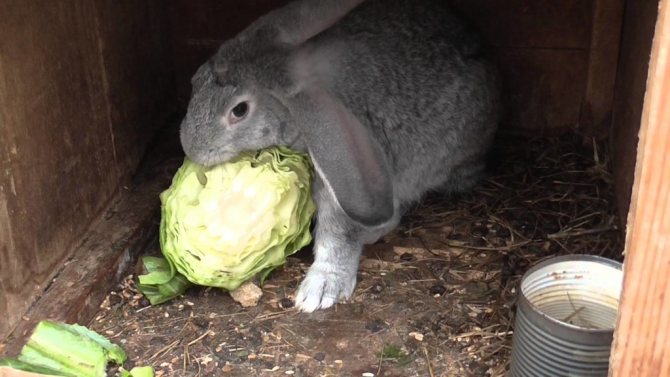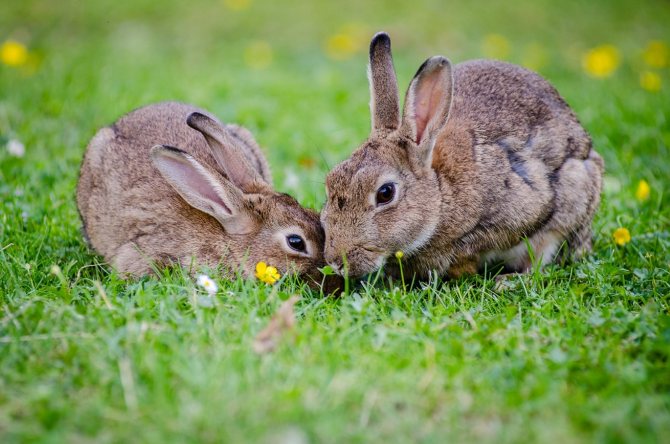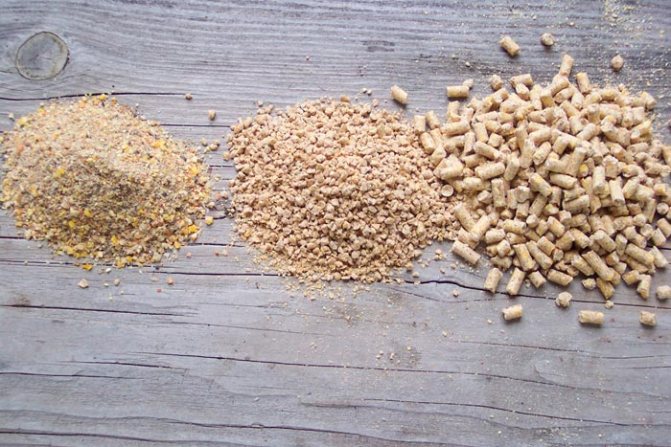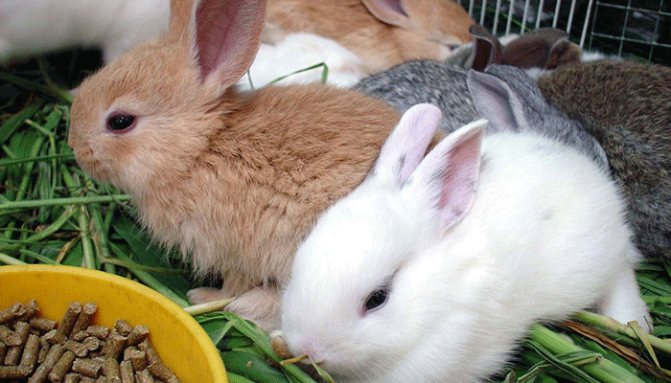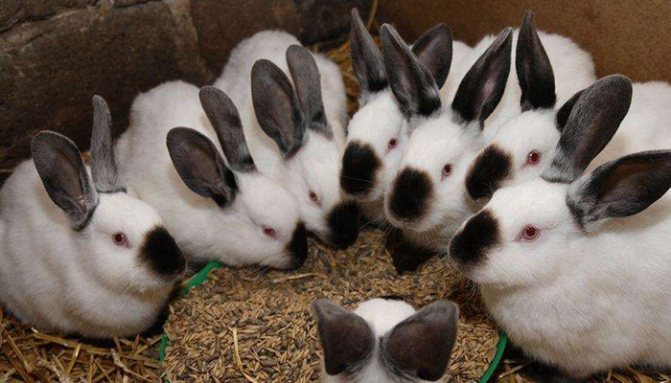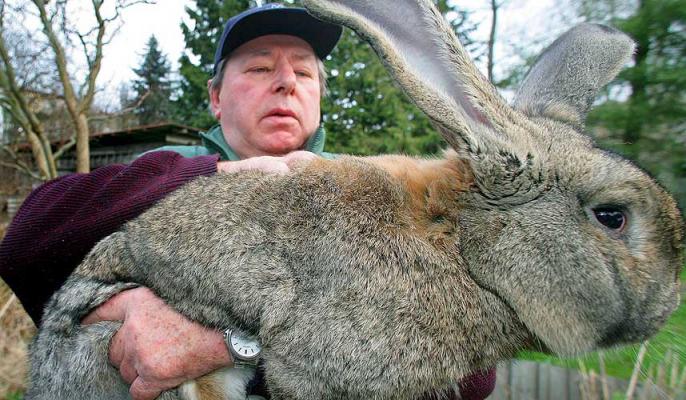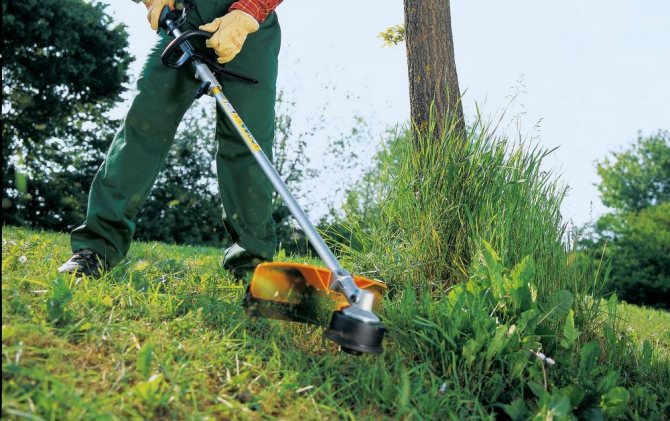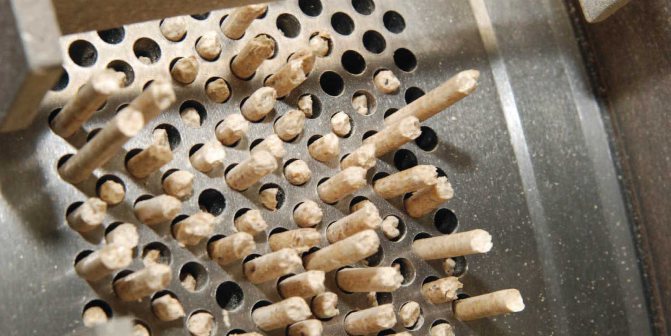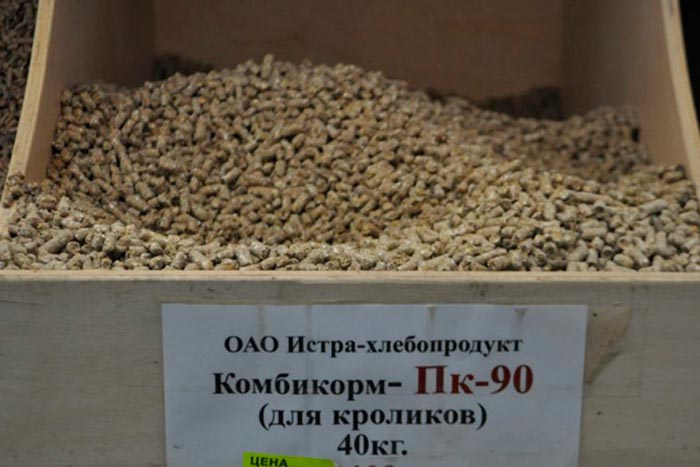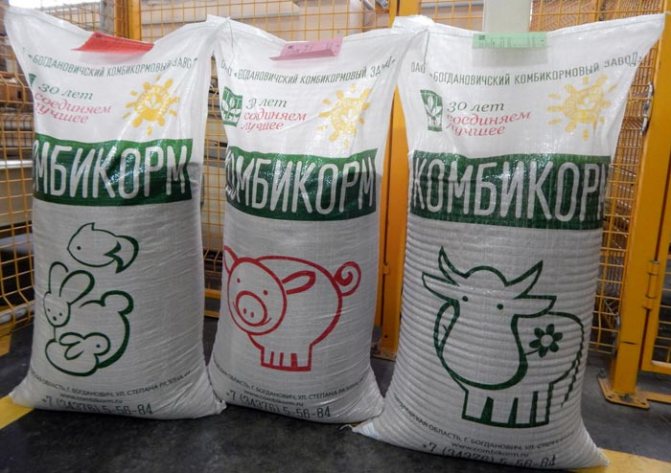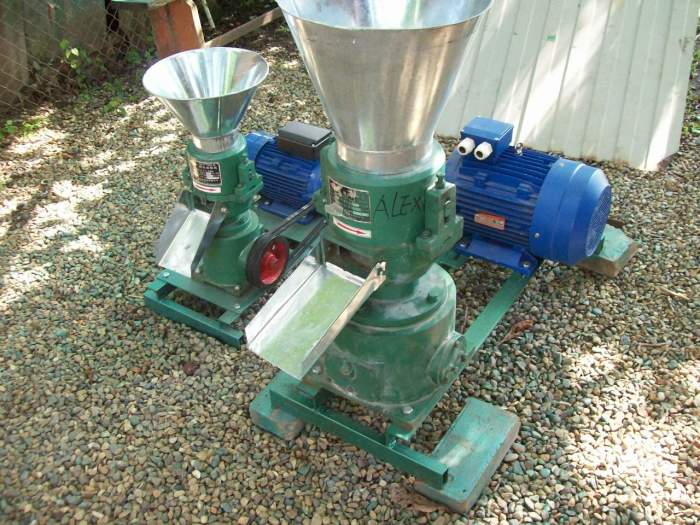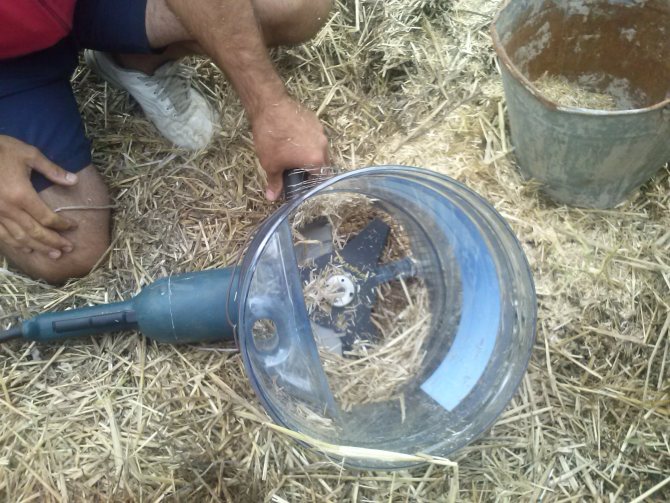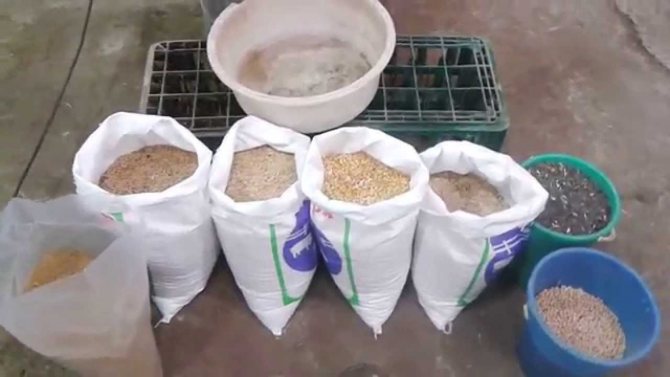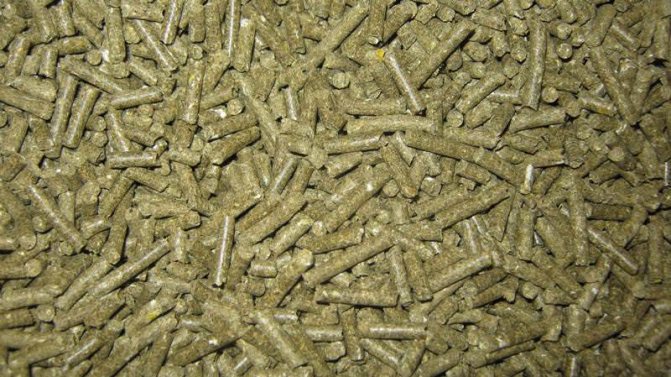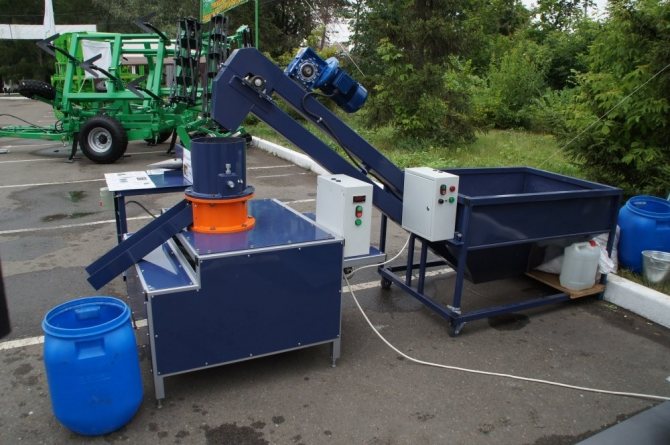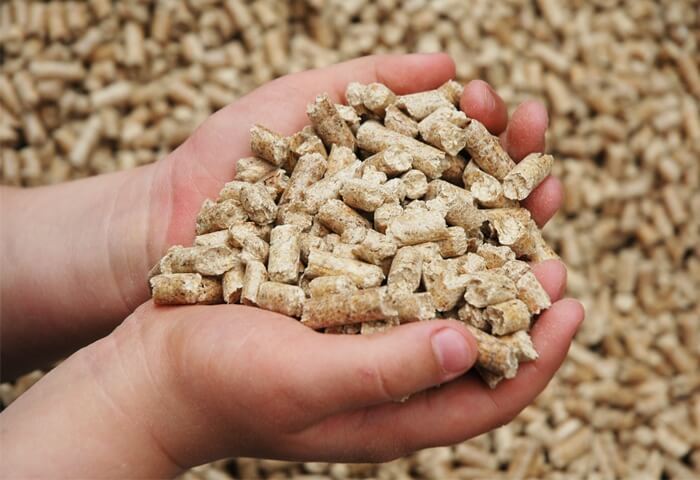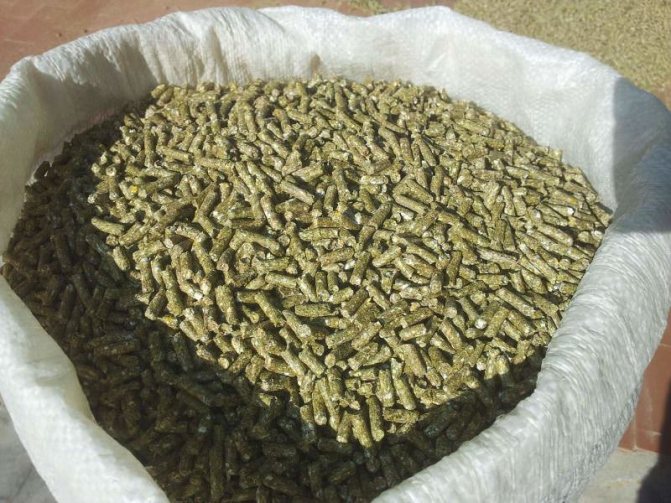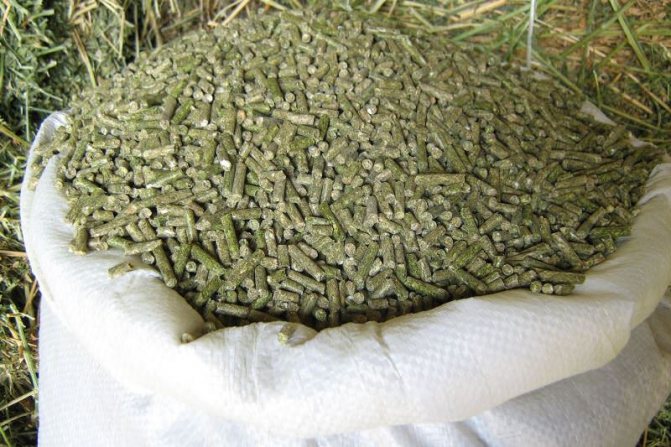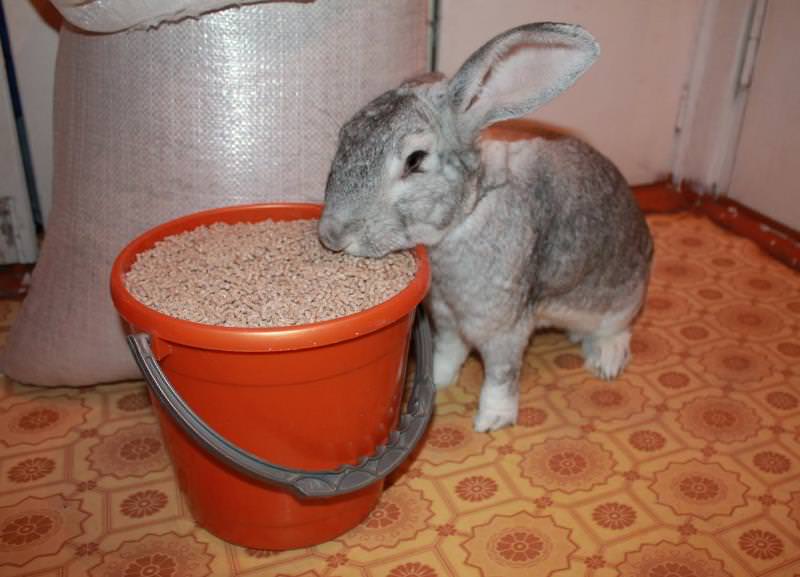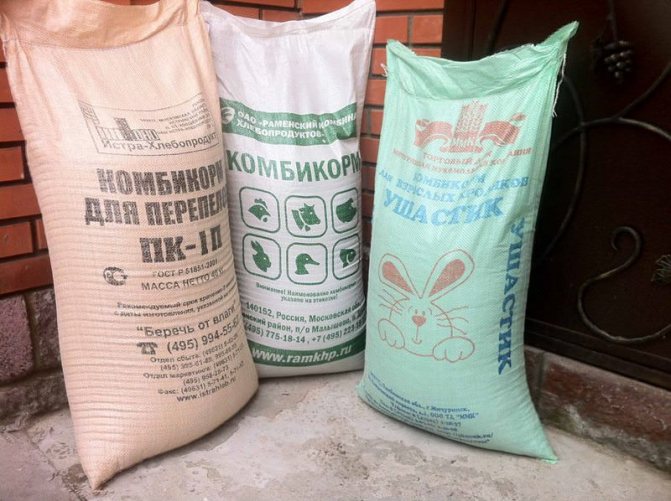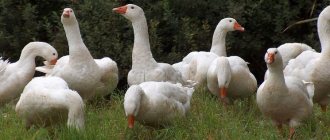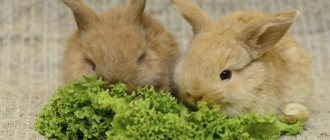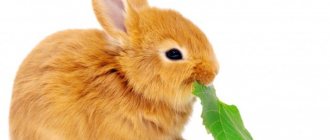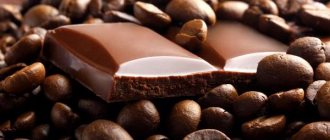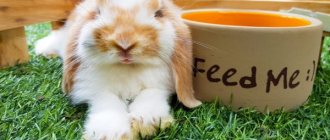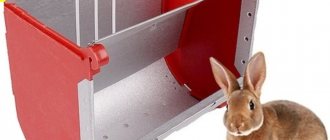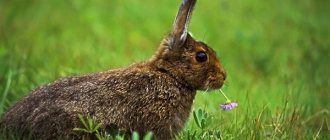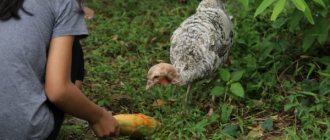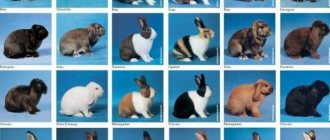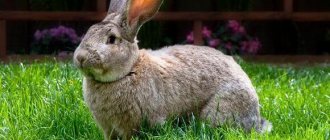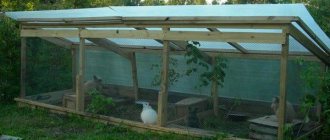Any rabbit breeder independently selects the optimal diet for pets, taking into account their age and state of health. The primary task of the farmer is not only to feed the animals, but to provide them with minerals and vitamins in optimal quantities. The easiest way to achieve the desired result is to use compound feed for rabbits.
Compound feed - a mixture of grains, plant materials and additives
Diet concept
Today, a large number of different breeds are known, which have significant differences in size. Of course, you cannot give the same amount of food to a dwarf rodent and a giant.
In the summer, animals should receive green mass, which significantly reduces the cost of expensive concentrated feed. Rabbits will be happy to eat not only cereals, but also the tops of garden plants. Root crops, silage (in winter), vegetables are also eaten. All of the foods listed above are rich in carbohydrates as well as vitamins.
Particular attention is paid to potatoes when feeding: vegetables with green parts should not get to animals (they are poisonous to rabbits). You can give both raw potatoes and boiled ones. Many farmers use this valuable product as an additive to the mash, additionally using compound feed, meal and cake.
Silage is an excellent food for rodents during the winter, providing the animals with vitamins that are more needed during the colder months. This feed is prepared from various components, for example:
- corn;
- sunflowers;
- cabbage foliage;
- beet tops;
- carrot;
- pea stems;
- green parts of oats;
- forbs.
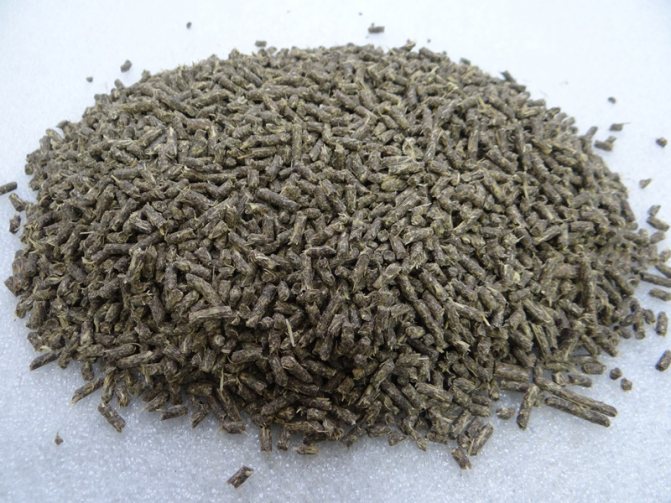
Also, in winter, instead of grass, hay, straw, and branch fodder are used. Before feeding the straw, you need to pay attention to its quality. Only some of its types can be given to animals:
Everything else is not suitable for feeding rabbits, but it will work as a bedding.
Compound feed is an obligatory part of the diet. It is convenient because it contains all the useful components necessary for animals, nutrients and vitamins in an ideal ratio. However, the price of such food is not the most affordable. Compound feeds are produced for various groups of animals, depending on their age, physiological characteristics and productive qualities. If the owner of the farm has no desire to make unnecessary expenses, then such food for rabbits can be made on your own farm, having the following components:
All of them are crushed and mixed in certain proportions.
The best manufacturers of compound feed
Farmers have long been using ready-made mixes for their own and pets. The most popular were:
- PURINA multicomponent mixture of guaranteed high quality for fattening young stock;
- City Wend, produced according to GOST 32897-2014. It contains about 16% protein and about 8% fiber;
- New Agrosnab produces a ration for rabbits of two age categories;
- Invest URFO sells pelleted rabbit feed in bulk at an affordable price;
- The Bogdanovichi feed mill produces universal feed for rabbits.
Have you tried giving industrial compound feed to rabbits?
Variety of feed
From the above, it becomes obvious that the diet of rabbits consists of very diverse components, and therefore it is worth getting to know them a little better.
All feeds can be divided into the following categories:
The green mass includes grass that appears in natural conditions in fields and meadows with the onset of the warm season or specially sown by humans. Among meadow crops, rabbits prefer alfalfa, clover, and wheatgrass. The second type of grass should be handled very carefully, because its overabundance leads to the fact that the rabbits lose their reproductive function.
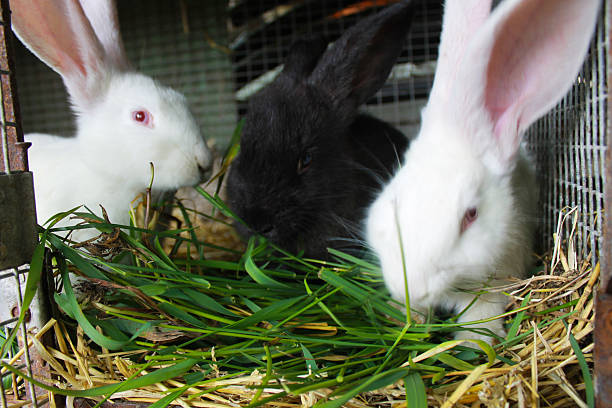

Can be used in feeding and tops of various crops. Beet tops are introduced with extreme caution in the diet. it leads to indigestion. You need to feed it in small quantities and watch the reaction of the animals (if necessary, you just need to remove it from the diet). Also, the tops contribute to rapid weight gain, which is not always necessary for the owner of a rabbit farm.
Norms for animals in different physiological stages
Animals need to be fed depending on the age and condition of the rabbits, as well as the seasonality. The approximate rates can be found in the following table. The amount of feed is indicated in grams.
The daily rate for rabbits of different types of feed should fully satisfy his needs. It changes depending on the gender, age of the rabbit, and also on the season. For example, pregnant and lactating females need more food. The norms for growing young stock are calculated separately. In cold weather, rabbits are given an increased amount of food, since a lot of energy goes into heating. Let's take a closer look at what feed to give the rabbits, and how much.
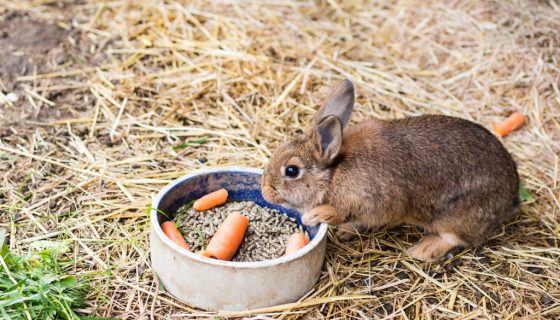

Daily feeding rates for rabbits
Varieties of feed
The speed of growth of their mass, health, taste of meat and quality of fur largely depends on the correct feeding of rabbits. In order to calculate the daily feeding rates for rabbits, you need to know what food they need. So, the daily diet of a domestic rabbit includes the following types of food:
Green foods include grass, root vegetable tops, kale, and legume stalks. Roughage is hay, tree twigs, straw, dry leaves. Juicy foods include root vegetables, pumpkin, squash, cabbage leaves, and some fruits. Concentrated feed is made from grains, legumes (peas, beans, etc.), bran, cake. These include self-prepared or industrial compound feed. Also, rabbits are given bone, meat or fish meal as concentrates.
Compound feed production at home
Self-preparation of compound feed will not only save the annual cost of purchasing ready-made feed, but also allow you to control the quality of the components of the diet. To start home production, you need a machine called an extruder. With its help, the compound feed takes the form of granules. This is due to the heat treatment and pressing of the ingredients poured into the unit. Thanks to the different attachments, feed of different diameters can be obtained. Larger pellets are used for large livestock. For rabbits, smaller compound feed is usually made.
Extruder
Feed Granulator Prices
Feed Granulator
What is required for the manufacture of compound feed at home
In order to mechanize the work on the preparation of compound feed as much as possible, some costs will be required. However, they will pay off very quickly if you prepare compound feed not only for yourself, but also for sale. Concentrated feed production requires the following equipment:
- Motokosa will easily help to prepare hay even on an industrial scale.
- Hay dryer allows you to reduce the time waiting for the result.In the process of turning grass into hay, the product may not dry out well due to rain and adverse weather conditions. The dryer minimizes risks.
- Hay chopper helps to quickly achieve the required size of the ingredients for the mixture.
- Grain crusher grinds coarse ingredients into flour or a homogeneous product.
- Oil press necessary for crushing seeds. It can also be used to produce oil. The purchase of such a unit is important, but not necessary in the first stages of home production.
- Extruder converts powdered products into compressed granules. This process is necessary because pulverized feed can clog the lungs of animals and kill rabbits.
Harvesting grass with brushcutters
Solar dryer for hay and forage grasses
How to calculate feed rates
The daily feeding rates for rabbits are calculated in different ways. The most common are feed units. One feed unit corresponds to a kilogram of medium quality oats. In rabbit breeding, it is customary to designate feed units by grams. This means that 100 grams of feed units corresponds to one hundred grams of oats. Also, feed is considered by the amount of proteins contained in them, energy value (kJ or kcal). Let's see what the daily ration should be for one head, based on feed units (since this method is the most popular):
- Female and male that do not breed - 120 (summer), 160 (winter)
- When preparing rabbits for mating - 180 (summer), 215 (winter)
- Feline female - 195 (summer), 230 (winter)
- Lactating female with 6-7 rabbits for 1-15 days - 315 (in summer), 350 (in winter)
- Lactating female from 16 to 30 days - 450 (summer), 500 (winter)
- Lactating female 31-45 days - 650 (summer), 700 (winter)
- Rabbits 46-60 days - 100 (summer), 120 (winter)
- Rabbits 61-90 days - 140-160 feed units
- Young stock 91-120 days - 180-200 feed units
- Young growth 121-200 days - 200-225 feed units.
Green forage and hay in the rabbit's diet
How to calculate the rate of feeding green food per rabbit head? For a female and a male that do not breed, 800 grams of fresh grass or 200 grams of dry hay must be eaten per day. When the female is waiting for the rabbits, the amount of grass is increased to a kilogram, but the hay, on the contrary, is slightly reduced. The rabbit is given 175 grams per day, increasing the percentage of concentrated feed at his expense. The nursing female is given 1.5 kilograms of grass or 300 grams of hay.
When compiling the daily rate of hay and green forage, its composition matters. If it contains a lot of legumes, reduce the amount. If the weight of the feed remains the same, the ration of the concentrated feed is reduced by 10-15%. Most experienced breeders do not recommend getting carried away with legumes. Their excess increases the risk of developing coccidiosis, in rabbits the belly swells. The only exception is meat breeds, which will soon be slaughtered. But even in this case, it is advised to give more compound feed than hay with legumes.
What to feed rabbits: types of feed
To determine the nutrition of rabbits, it is worth considering the following nuances:
- nutritional norms;
- productive qualities of animals;
- nutritional value of feed;
- breed, age of animals;
- type of feeding;
- season;
- biological characteristics of rabbits.
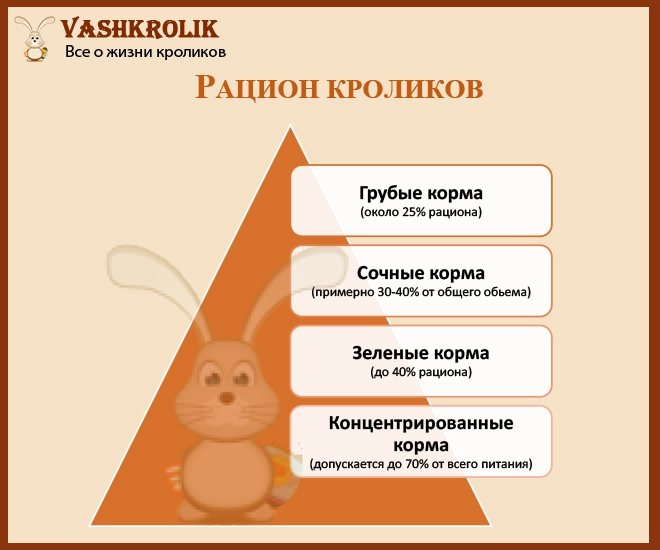

Roughage
The main choice in food for rabbits during the cold season. Such food is nutritious and covers all the needs of eared animals in winter.
- Hay. The basis of the winter diet. Vitamins, minerals, about 6% protein easily digestible by animals. Quality is determined by color, pleasant smell. The permissible humidity is 14-18%. For harvesting hay, herbs are usually chosen that have not begun to bloom and spike. Plants such as dandelion, shepherd's purse, plantain, sorrel, thistle, nettle are highly recommended.For lactating females, legume-based hay is recommended.
- Straw. A quality product - clean, light, elastic, with a sheen. They are given when the rabbits lack fiber (it is allowed to replace part of the hay - up to 45 -50%). Rabbits prefer straw, pea, lentil, millet. Grain straw is not suitable for feeding; it is used as bedding in cages.
- Branch feed. The branches of the trees are as nutritious as wild straw. They contain many vitamins and minerals. It is permissible to replace with branches up to half of the diet. Animals love to crunch branches of willow, acacia, mountain ash, oak, apple, poplar, hazel, maple, raspberry.
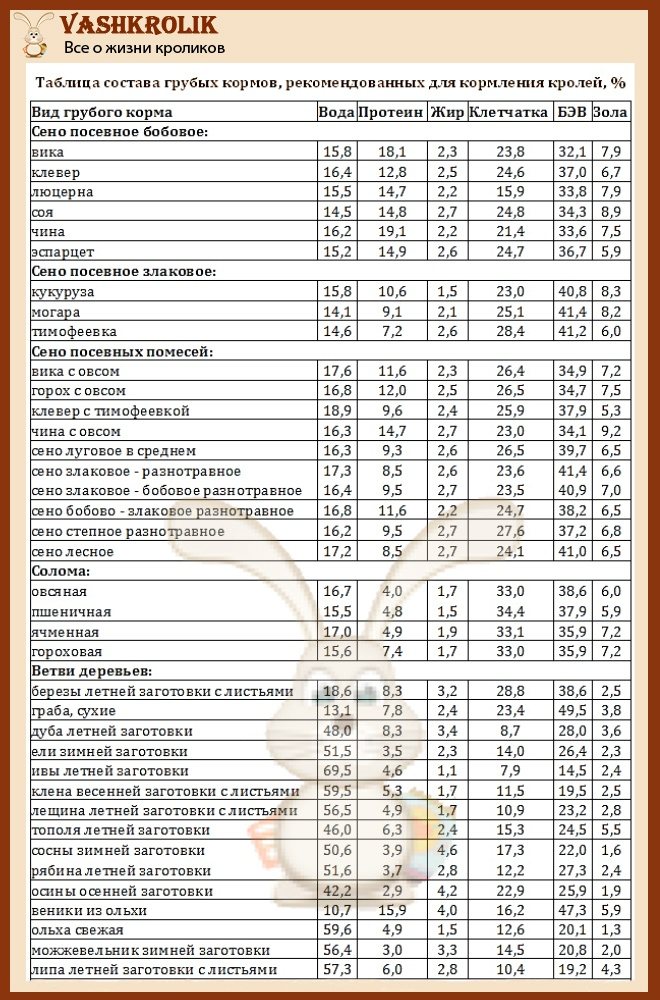

Green feed
The basis of the summer diet. A source of vitamins, proteins, minerals, carbohydrates that are easy to digest.
- Forest herbs. Very fortified and varied composition. Dandelions, wheatgrass, sainfoin, clover, alfalfa, plantain are especially suitable. It should be remembered that large amounts of clover have a negative effect on the reproductive performance of rabbits!
- Meadow plants. Animals eat sorrel, tansy, burdock, horseback, heather, sweet clover, sage, sow thistle with great appetite.
- Steppe herbs. It is best to take yarrow, bitter wormwood.
- Leguminous grass. An excellent choice is stalks of peas, soybeans, sainfoin.
- Grass plant. Animals like green shoots of corn, oats, barley, timothy very much.
Experienced rabbit breeders recommend harvesting the grass in the first half of the day, and then wilting it a little before serving it. Giving rabbits grass covered with dew or after rain is completely undesirable!
Juicy feed
- Silage. These are fresh herbs that have been chopped up and preserved. An excellent choice is Jerusalem artichoke tops, corn stalks, cabbage, carrot leaves. To make high-quality silage with your own hands, the grass is dried to a moisture content of about 55%, crushed, thoroughly rammed in containers or pits, and hermetically covered with a film on top.
- Roots. In the composition - up to 85% water, some proteins, fiber, fats, minerals. Animals with appetite eat beets, carrots, potato tubers (boiled).
- Melons. The best choice for the autumn diet is watermelon, squash, zucchini, pumpkin. They contain large amounts of carbohydrates and vitamins.
- Succulent plants. Excellent food for rabbits - cabbage, rhubarb. In the composition - carbohydrates, vitamins.
Pumpkin has unique properties. It is an excellent anthelmintic agent. Therefore, it is not only an excellent food product for animals, but also a good prophylaxis against parasites.
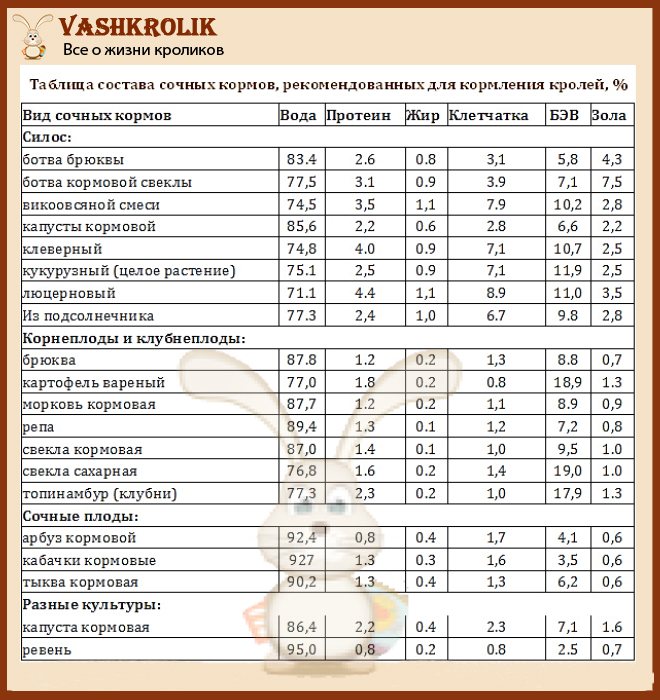

Concentrated feed
- Corn. Most nutritious. And oat, wheat, barley, corn grains are considered useful. Also give peas, soybeans. Provides most of the needs of eared pets.
- Bran. It is recommended to give wheat, barley, rye, buckwheat bran.
- Oilcake, meal. The little animals will be happy to eat the squeezed seeds of sunflower and legumes. They are rich in protein.
- Reverse This is skim milk whey. They are given dry or fermented in very small quantities as a source of calcium.
- Meat and bone meal, silkworm larvae. Bone meal is an excellent supplement for the prevention of bone diseases in rabbits (rickets, osteomalacia, osteoporosis). Pupae of silkworms are extremely nutritious, as they contain 60% protein and more than 20% fat.
- Compound feed (loose, granular). Perfectly selected complexes of combined feeds are able to provide rabbits with all necessary nutrients. Can be a single power source. In the composition - fiber, vitamins, microelements, which contributes to rapid growth, full development.
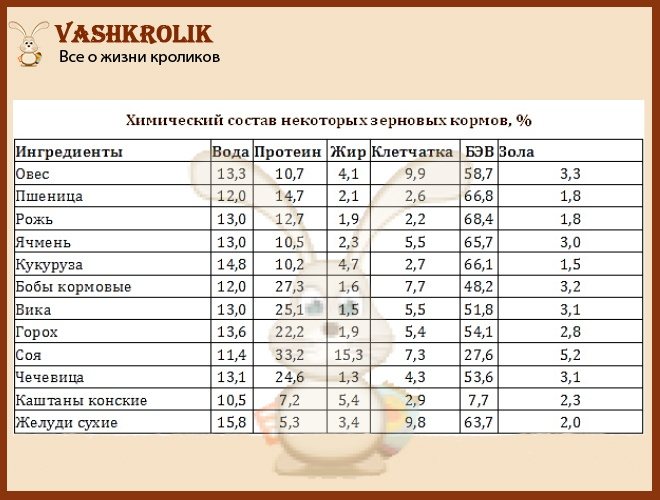

Both adult rabbits and young animals should eat food that contains a lot of proteins and fats. It is especially important to control the amount of vitamins and minerals consumed.
Juicy food in the diet
Succulent food must be included in the diet of domestic rabbits, regardless of the season. In summer, they are based on root crops (carrots, sugar beets, Jerusalem artichoke, rutabaga), zucchini, pumpkin, cabbage. In winter, add silage, raw and boiled potatoes. The rabbit eats food waste well - vegetable scraps, watermelon skins, etc. Succulent feed can be fed on its own or mixed with grain, grass or bone meal. Here are some of the daily allowances for succulent feed:
- Beets, rutabagas - 300 g
- Carrots - 300 g
- Waste vegetables - 200 g
- Cabbage leaves - 400 g
For pregnant and lactating females, this rate can be increased by 100 and 200 grams, respectively. Cabbage leaves are given with caution, observe whether the belly of the rabbits swells from them. Food waste should be only fresh, without signs of rot, and always clean.
Concentrated feed
The diet of rabbits must necessarily include concentrated feed. A small amount of them contains a lot of nutrients and protein. Animals that eat it quickly gain body weight. In winter, concentrates make up half of the rabbit menu, as green grass is not available during this period. The most profitable is feeding rabbits with compound feed. What does it consist of? About 40-50% of the compound feed is made up of cereals, wheat, corn, oats, barley. The rest is sunflower or soybean cake, bran from wheat, oats, barley, soybean meal.
Also in the compound feed include meat and bone meal, which is a source of protein and calcium, improves the taste of rabbit meat. Instead of meat and bone meal, you can add meat or fish meal to the compound feed. Its percentage should not exceed 5%. Be sure to add a complex of vitamins and minerals to the combined feed - table salt, chalk, calcium phosphate and a premix for rabbits (or other vitamins).
In modern livestock farming, rabbit breeding is a lucrative business. Rabbits are a valuable source of meat and fur for outerwear.
What compound feed is best for rabbits
Experienced farmers recommend purchasing special feed for rabbits. It is marked with the symbol PC (complete feed) 90 and further:
- PK 90, PK 91 give young growth from the moment of jigging up to 4 months;
- PK 92 is suitable for adults;
- PK 93 is a special composition for fast fattening of young stock, starting from 2 months.
When feeding feeds labeled PC, the animal is not given vitamins and other additives, except for hay.
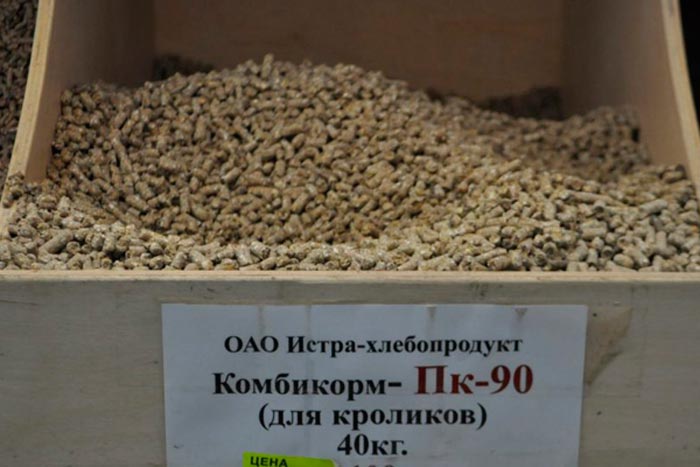

The mandatory list of ingredients includes:
- grain feed and grain waste (oats, barley, corn, peas, bran);
- sunflower cake or meal;
- herbal granules from alfalfa or other herbs;
- fish, meat meal;
- feed and hydrolytic yeast;
- edible salt;
- a piece of chalk.
Preservatives and components that improve digestion are introduced into the feed.
Compound feed marked KK is a mixture of grain and herbal granules, dried vegetables, without the addition of a vitamin complex. The diet is supplemented with the introduction of a premix or BMVD (protein-mineral-vitamin supplement).
Benefits of feeding with compound feed
Compound feed for feeding rabbits
If the rabbits are fed incorrectly, that is, with whatever comes to hand, then it will be impossible to get tasty meat and high-quality skin. Detailed information on what and how to feed rabbits at home can be found in this article.
A complete diet for these animals should contain all the useful vitamins and trace elements that are found not only in fresh and green feed, but also in compound feed.
Among the advantages of feeding with compound feed should be highlighted:
- easy transportation and storage;
- the right amount of nutrients;
- optimal balance of energy-protein ratio;
- fast weight gain;
- saving time spent on farm maintenance;
- minimization of funds for the purchase of feed.
In addition, the introduction of a combined feed into the diet reduces the risk of gastrointestinal diseases in animals, which develop as a result of the ingestion of toxins that affect many vegetables and cereals.
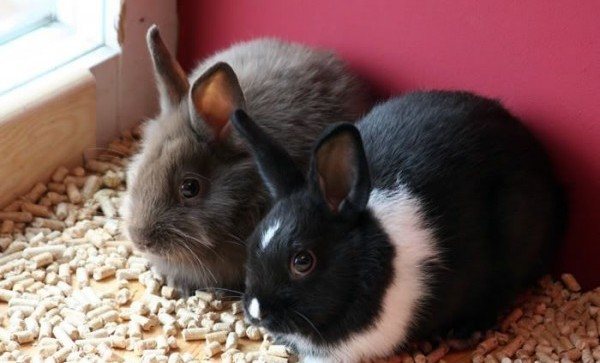

Components of complete feed
Compound feeds for any animal have a complex composition. They take into account the physiological, age characteristics and the purpose of growing this particular species. Therefore, you need to purchase ready-made complete or concentrated feed for the type of animals that you are raising, that is, for rabbits.
They are formulated on the basis of scientifically based feeding standards. According to the standard, the following requirements are imposed on ready-made rabbit compound feed, as shown in the following table.
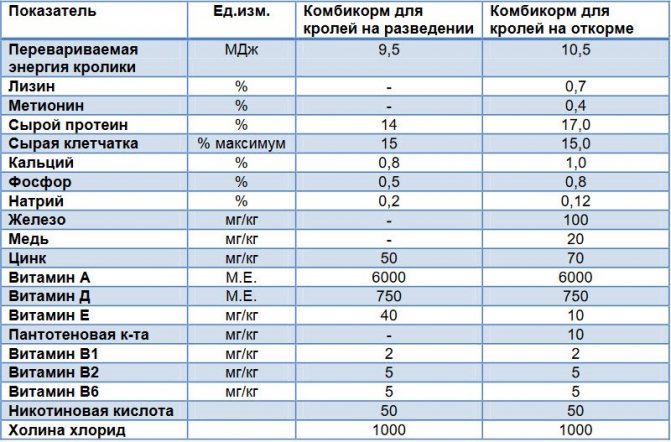

Amounts of substances for rabbits
As can be seen from the table, in addition to crude protein and crude fiber, a complete feed for rabbits includes trace elements, minerals and vitamins. The inclusion of crude fiber in compound feed is imperative. Without it, proper digestion of food is impossible.
But it is its presence in compound feed that makes it so expensive. Since crude fiber is mainly represented there by wheat bran and alfalfa flour. The production of this herbal flour is an energy-intensive, labor-intensive process. Since this product is made from alfalfa, which is artificially dried and then crushed.
Often, various coccidiostatics are added to the finished compound feed for the prevention of coccidiosis.
Which is better - grain or compound feed
Grain is one of the staple foods for rabbits. The best food for them is oats, which contain many nutrients..
In addition, oats are dietary, and by taking it as a basis for feeding animals, you can not be afraid of the development of obesity.
Rabbits can only eat grains. But, firstly, it will increase the cost of the feeding process, and secondly, it will complicate this procedure. In addition, it will be difficult for a farmer to obtain quality meat and skin.
And the next article tells you how to make a drinker for rabbits yourself.
Can rabbits be fed with one compound feed?
Recipe for proper rabbit nutrition - high-quality compound feed
The composition of the granulated feed includes all types of concentrated feed, vitamins and mineral supplements.
Many farmers switch rabbits to feed only with compound feed. For improvement, a probiotic and a coccidiostatic (medicinal substances) are added to its composition so that the animals do not develop coccidiosis (the liver and intestines of the rabbit are affected).
Dry feed mixtures for feeding rabbits
| Purpose of use | Manufacturer name | Main ingredients | Features of the |
| For breeding rabbits for meat and skins | Multigain | Barley, oats, bran, soybean meal, sunflower meal, feed yeast, chalk, salt, vitamin and mineral complex, antioxidants, coccidiostatic | Increases immunity, productivity. milkiness; prevents coccidiosis in rabbits |
| Feed & Life (Feed end Life) | Fiber, vitamins, minerals, amino acids, soybean meal, sunflower meal, bone or herbal meal, yeast, coccidiostatic, antibacterial complex | Improves growth, maturation, increases resistance to infectious diseases | |
| Purina | Grain mixture, sunflower meal, grass flour, wheat bran, beet pomace, sunflower oil, chalk, amino acids, vitamin and mineral complex, probiotic, cocciodiostatic | Improves digestion, does not require additional feeding with hay, improves growth and productivity | |
| Shuya | Grain mixture, wheat bran, sunflower meal, herbal flour, chalk, salt, vitamin and mineral premix, antioxidants | Improves growth, productivity, fully covers the energy needs of the animal | |
| PROVIMI | Alfalfa flour, oats, corn, wheat, sunflower and linseed oil, chamomile and calendula extract, Jerusalem artichoke, kelp, palmaria, vitamin premix | Improves performance, digestion, saturates with the necessary vitamins and minerals | |
| For decorative rabbits | Vitakraft Menu(Vitacraft Menu) | Alfalfa, oats, bran, oat flakes, sunflower seeds, molasses, pea flakes, wheat, carrots, chalk, rapeseed, soybeans, yucca, vitamin and mineral complex | Effective saturates, improves digestion, normalizes intestinal microflora, strengthens the immune system, has a beneficial effect on health |
| Jr Farm (IRFARM) | Grass flour, wheat, extruded corn, hay, oats, carob, pea flakes, bran, sunflower seeds, malt inclusions, carrots | Has a beneficial effect on development, growth, improves digestion | |
| LoLo Pets | Cereals, linseed, sunflower, feed yeast, minerals | Adequate Nutrition for Optimal Growth and Development | |
| Benelux Funny
| Alfalfa, carob, corn flakes, wheat flakes, corn, peas, barley, flaxseed oil, salt, triticale, minerals | Provides balanced nutrition, good health, good immunity, strengthens teeth, coat quality, improves digestion | |
| Little One (Little Wan) | Herbal granules, soybeans, wheat, lupine flakes, carob, peas, corn, carrots, molasses, vitamin and mineral premix, oregano | Optimal growth and development, prevention and treatment of coccidiosis | |
| Fiory | Forage, bran, grain, carob, oil-bearing fruit seeds, feed yeast, honey, minerals, oils and fats, inulin yucca extract | Improves health, improves bowel function, protects the body, eliminates ammonia emissions | |
| Padovan | Sunflower seeds, corn, barley, lentils, carrots, apples, carob, granules: grain, sugar and its by-products, dairy additives, trace elements | Improves the condition of the coat, skin, helps to strengthen the protective functions of the body |
Types and composition of compound feed
There are a lot of food for rabbits. Some are used for fattening meat breeds of animals, others are purchased for young individuals, and still others for females on the drift or during lactation. Compound feed concentrates are the main type of feed for rabbits.


Rabbit feed recipes
The specific gravity of concentrated feed in the annual consumption reaches 50%. The group of concentrated combined feed includes the following grains:
Beneficial features
It is very convenient to use combined feeds in feeding rabbits. This is not only saving time for fattening, production, but also protection against diseases. The use of this product reduces the risk of developing gastrointestinal diseases on the farm, which may occur due to mushroom poisoning. Fungi are found in many types of foods.
The basis of the combined feed is represented by ground cereals:
This component accounts for 30 - 45% of the total mass of the feed. The second group of components contains a lot of protein. These components are:
- soybean meal;
- wheat bran;
- sunflower cake, soybean;
- meat and bone meal, non-food fish;
- vitamin-herbal flour;
- hydrolyzed yeast.
The third component of the combined feed is the vitamin and mineral complex. It is balanced and includes:
For rabbits, you can feed that is intended specifically for this type of domestic animal. Vitamins have a number of positive effects on the body:
- A - helps to improve the function of reproduction;
- B - has a good effect on the digestive tract;
- C - strengthens the immune system;
- D - promotes the absorption of minerals. Essential for structuring bone tissue;
- K - necessary for rabbits at the time of breeding;
- E - Has an effect on the development of muscle fibers, the ability to shape, the functioning of the heart muscle.
Daily feed rates
The daily diet of rabbits depends on the breed, season and physiological characteristics of the animals. With mixed feeding in the normal state, females and males per day need:
- In the summer: green food 450-550 g, concentrated feed 50-60 g.
- In winter: fresh feed 200-250 g, concentrated 60-70 g and hay 110-160 g.
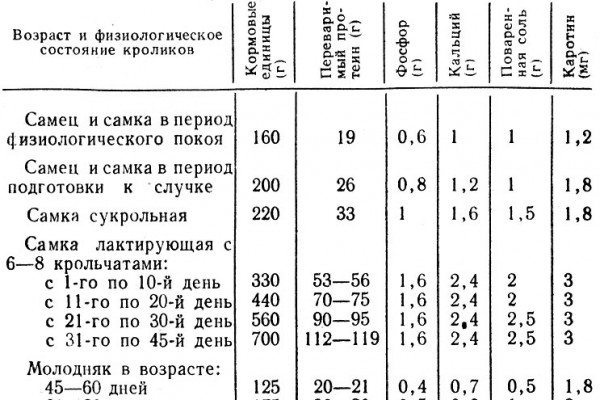

When feeding with full-feed granulated compound feed, adults are fed 3-4 times a day. The consumed rate is 250 g per head. The diet of pregnant rabbits should include:
- fresh feed 600-750 g, concentrated feed 70-90 g;
- during lactation: green fodder 1200-1500 g, concentrated feed 130-160 g, hay 250-300 g.
From the following video You will learn how to make compound feed for rabbits at home:
DIY compound feed
Despite the variety of ready-made feeds, some rabbit breeders make compound feed for rabbits with their own hands. At first glance, it seems that the process is time-consuming, but if desired, it can be mastered. The first thing you need is to purchase the necessary equipment:
- granulator;
- a crusher for grinding grain;
- screw oil press;
- hay dryer;
- hay chopper;
- petrol cutter.
Of course, this list of equipment, if you buy it for self-production of feed, will justify itself only with a large number of rabbits. You need to start with the preparation of the feed ingredients: dry the grass and take the ingredients (cereals, cake, bran, etc.) in the right proportions in accordance with the selected recipe. After crushing them, the resulting mixture must be mixed in water, and then passed through an extruder. This equipment performs mixing, shaping and heat treatment of ingredients. The size of the granules for rabbits can be different, depending on the attachment used. If you produce compound feed only by means of a granulator, i.e. without heat treatment, its shelf life will be shorter. In the absence of the aforementioned technique, the compound feed in granules can be made using a kitchen meat grinder. As a last resort, you can give the animals a mixture without granulating.

